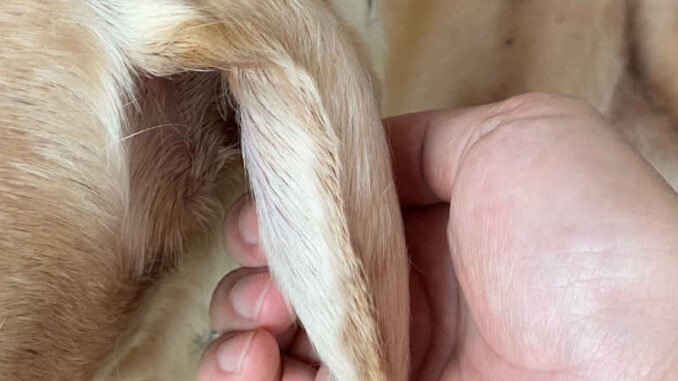
This article was updated on March 12th, 2024

You’ve found a crazy-looking lump on your dog’s ear and are wondering what you can do to help your poor friend. At my clinic, ear hematomas are commonly seen in dogs with chronic allergies; they are more common in Spring and Summer. In this article, we will review home remedies and tips to help your dog with their ear hematoma (while you also work with your veterinarian on diagnosis and treatment).
How can I tell if my dog has an ear hematoma?
The most obvious sign is a swollen, puffy ear flap, as shown in the picture below:
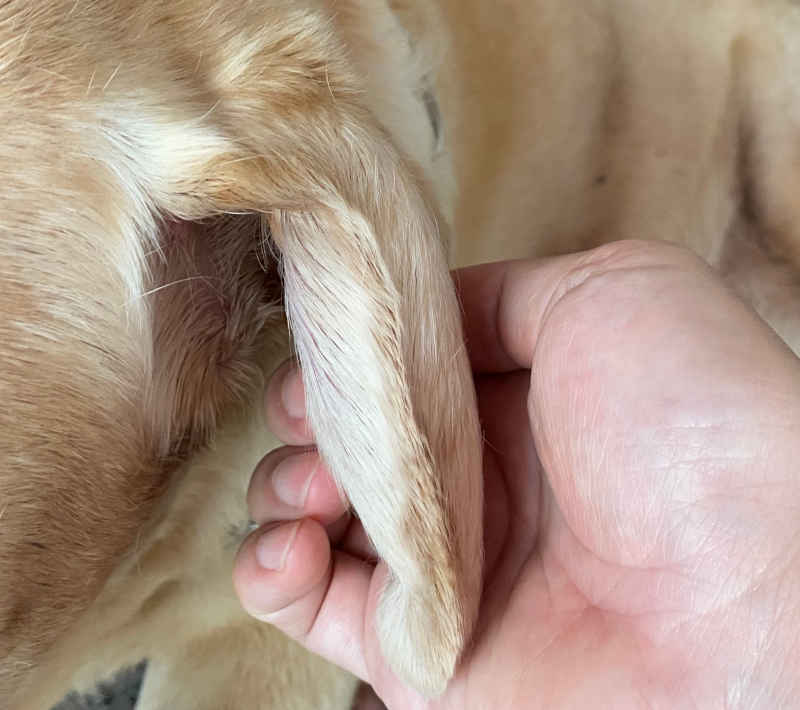
However, your dog may show one or more of the following symptoms:
- Earflap (pinna) that is warm to the touch
- Ear discharge
- Ear odor
- Head shaking
- Head tilting
- Head scratching
Before you start a treatment at home, make sure you know the cause
Problems like ear infections, food allergies, and foxtails are often there for months before a hematoma appears. Because ear hematomas are usually caused by an underlying problem, you should consult with your veterinarian. They will want to examine your dog for:
It’s important to have your dog evaluated before you attempt at-home treatment; this way, you’re treating the problem that caused the issue to begin with.
- Skin Allergies
- Food Allergies
- Ear infections
- Ear mites
- Ticks
- Insect bites
- Foreign bodies (foxtails, etc)
Can home remedies help an ear hematoma?
There are some home remedies believed to be effective in healing hematomas. However, you should always have a veterinarian approve ANY home treatment. There is always the chance your dog may react badly to home treatment.
Common at-home treatments include:
- Arnica, best for simple hematomas, Arnica is a homeopathic remedy applied directly to the hematoma. It is believed to help the blood resorb quicker. However, Arnica can be dangerous if used incorrectly so make sure you check with your veterinarian first.
- Head Wraps, help keep ears secure, decreasing trauma from scratching or shaking (see FAQs below).
Things you can do at home to help your dog
If you notice your dog has an ear hematoma, bring them to a veterinarian right away. Ear hematomas are very uncomfortable, and home treatment is not recommended. However, there are a few things you can try at home.
1. Apply a cool towel
Grab a clean towel and dip it in chilled distilled water. Wring it out so that it is slightly damp and gently hold it on the hematoma. The cool temperature should give your dog temporary relief from pain, inflammation, and itching.
2. Put an e-collar on your dog
E-Collars or Elizabethan collars work by keeping your dog from scratching at his head. The cone-shaped shield creates a barrier, preventing your dog from scratching his ears. Keep the e-collar on until you see the vet. You can purchase an e-collar from your veterinarian or a local pet supply store.
It is best to have your veterinarian help you fit your dog’s e-collar. However, if you need to fit it yourself, there are a few rules you can follow.
Follow these steps for a perfect fit:
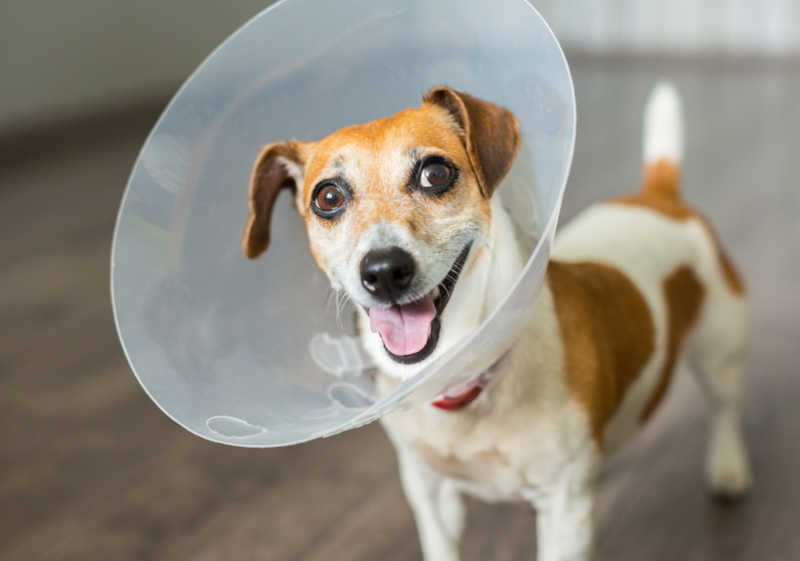
- Bring your dog to the pet store or vet’s office and ask them if you can test an e-collar out.
- Purchase an e-collar that extends just past your dog’s nose.
- When you secure the e-collar, make sure there is a two-finger width space between your dog’s neck and the e-collar.
- Ensure the collar isn’t too long, as it will be difficult for your dog to eat and drink.
- Make sure the plastic base of the e-collar (around the neck) isn’t digging into the skin.
3. Clean and drain the hematoma (only if it bursts by itself):
It is uncommon for a hematoma to burst or pop, but if you find yourself in this situation, you can clean it yourself.
Follow these steps:
- Mix a small amount of chlorhexidine solution with distilled water (I use 2% chlorhexidine diluted at a 1/30 ratio.) This means that if you have 1 tablespoon. of 2% chlorhexidine solution, you will need to mix it with 30 Tbs. of distilled water. (Note: Chlorhexidine can be purchased online or at a pet supply store.)
- After mixing the anti-bacterial solution, use either gauze squares or a clean towel to gently clean the outside of the hematoma.
- Once the hematoma is disinfected, you can drain it by applying gentle pressure to the ear. Do not force fluid out of the wound. If the fluid does not come out with gentle pressure, it is better to leave it.
- After cleaning the wound, wrap your dog’s head using a clean, soft, ace bandage or ear wrap. This will prevent the wound from getting dirty and filling up with blood again.
Important FAQs:
Should I use an ear hematoma wrap?
Wraps can help prevent, manage, and heal a hematoma. After treatment, your dog’s ear needs to stay as still as possible. Head wraps work by securing your dog’s ear, keeping it flipped up against his head, so his ear won’t fill up with blood when he shakes.

They also help by securing bandages used to catch fluid draining from the ear. While wraps can be helpful, it is important that you only apply them with advice from your veterinarian. If a wrap is applied incorrectly, it could cause more problems for your dog. See our article on head wraps for ear hematomas to learn more.
Remember, there is little benefit to treating the hematoma if the underlying cause is not addressed. If not, the hematoma will likely just be refilled once you remove the wrap.
Should I massage my dog’s ear?
Massage should only be done if your veterinarian recommends it. It is most helpful after your dog has already had surgical treatment. Your vet might ask you to massage your dog’s ear periodically to keep the hematoma from filling back up with blood. However, only do this with clean hands. If you do not wash your hands properly, you could spread bacteria to your dog and cause infection.
Will heat help my dog?
Warm compresses can be applied under specific circumstances. If your dog has already had treatment, your vet may recommend that you apply heat before milking the fluid out of the hematoma. This is only to be done if your veterinarian recommends it. Applying heat at the wrong time may cause an increase in inflammation, pain, and itching.
How can I help shrink my dog’s hematoma?
The best way to shrink it is to have a veterinarian treat it by draining it. If you try to drain it yourself, you can cause pain and introduce bacteria. You should never attempt to shrink an ear hematoma yourself.
How serious are ear hematomas?
They are very serious because they cause pain and pressure in your dog’s ear. And they are especially serious when left untreated. Because they are a symptom of an underlying problem, an ear hematoma left untreated can cause a worsening infection.
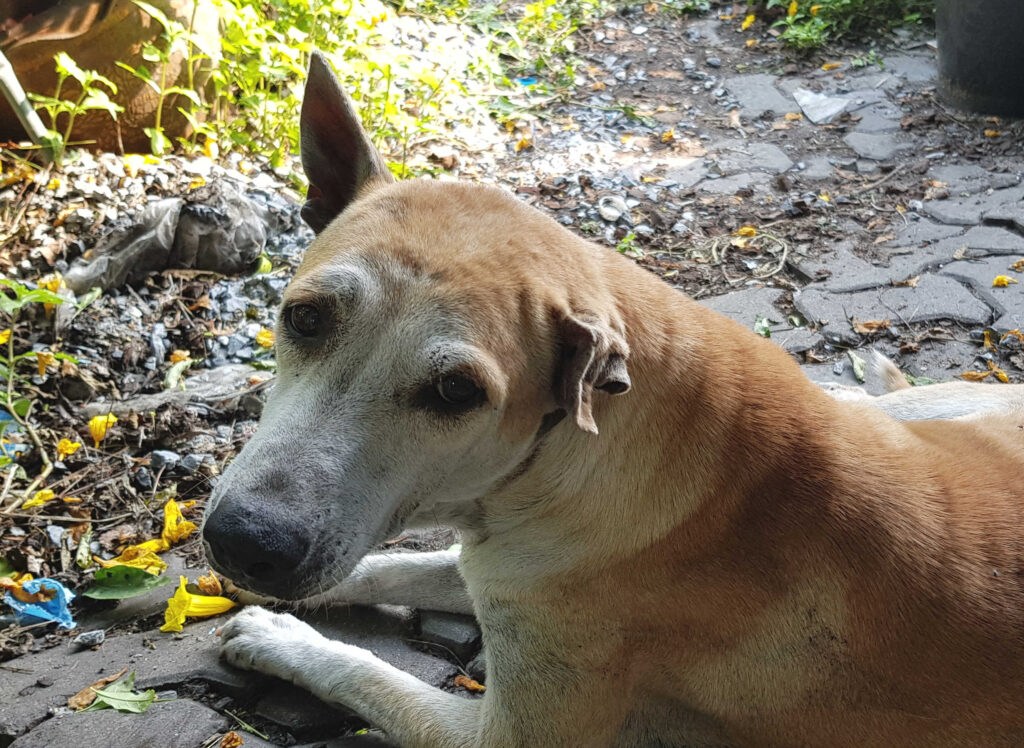
Why do untreated hematomas cause problems?
When they are left to heal alone, the blood will slowly clot and then eventually resorb. This can cause severe scarring, tissue death, and deformation of the ear flap (read our article about cauliflower ears for more details). Severe deformation of the earflap can cause a permanent blockage in the ear. Making it hard to medicate and treat the ear later on.
Untreated hematomas are also more likely to recur, since the underlying cause (such as allergies or a foreign body) may not be found by a veterinarian. If you decide to let your dog’s hematoma heal without treatment, you should still have your dog evaluated by a veterinarian, so the underlying cause can be treated.
Things You Should NOT Try At Home
It is natural to want to keep your dog from having surgery, but there are things you should NEVER try when trying to treat an ear hematoma at home. For example, you should NEVER:
Use sharp objects to drain a hematoma:
It is best to leave this up to a veterinarian. Cutting an ear hematoma open at home with a scalpel, scissors, or another sharp blade can expose your dog to bacteria and cause infection. It could also cause a large amount of bleeding that will be hard for you to control. Your veterinarian will use sterile (spotless) instruments to cut the hematoma. They will also save your house from a bloody mess!
Give your dog medication not prescribed for them:
It is never a good idea to give your dog any medication without checking with your vet first. Certain medications can cause toxic reactions in dogs.
How do I know how bad it is?
Mild hematomas are only slightly squishy and full, while severe cases are very puffy! If your dog has a severe case, his normally floppy ear may be so full of blood that it is standing upright. A severe hematoma can also be so large that it blocks your dog’s ear canal, making it hard to see in his ear.
Will my dog’s ear hematoma go away by itself, or will it need treatment?
While a hematoma can go away without treatment, it isn’t recommended. If you choose to let the hematoma heal itself, your dog could end up with:
- Severe scarring
- Tissue death
- Deformation of the ear flap
- Permanent ear canal blockage
- Recurrent hematomas
What other treatments are available to help?
Injectable homeopathy treatments:
In a 2020 study, Injectable treatment using homeopathic remedies (Rhus tox and Hamamelis virginiana) and oral (Bellis parents) healed a hematoma completely in just 30 days.
Cold laser therapy:
This therapy is effective at reducing inflammation. It can help it heal faster. Many veterinarians offer cold laser therapy, as it is beneficial in healing many injuries in dogs. You can ask your veterinarian if they offer this treatment.
Aural Splint:
Aural splints are a more recent option and cost-effective option available for dog owners. This treatment approach involves using fine needle aspiration to drain the clot and applying two ear-shaped plates on either side of the pinna. The plates are tailored to fit your dog’s ear and designed to prevent refilling of the hematoma. The splint limits the space in the ear and creates an environment that may allow natural healing of the ruptured vessel. This treatment method is a novel option, and should not be attempted without the approval and direction of your veterinarian.
When to see the vet
You should always bring your dog to the vet when they have an ear hematoma. Your vet can diagnose an ear hematoma with a quick physical exam. The vet will start by evaluating the ear by looking for swelling or trauma. If they suspect something is in the ear, they will use an otoscope to look into the ear canal for foreign objects. The treatment will depend on the underlying cause of the hematoma, the size, and your budget. The treatment options are:
Non-surgical treatment options:
Aspiration:
Aspiration is recommended for small hematomas when cost is a concern. During this procedure, your veterinarian will use a syringe to remove blood from the hematoma. This usually takes multiple visits because the ear keeps filling up with blood. Your vet may also inject a steroid medication into the hematoma after removing the fluid.
No treatment:
This is the least effective treatment, so it is not recommended. If you decide not to treat the hematoma, you should still visit the veterinarian to rule out underlying issues. With no treatment, some will go away. However, dogs that don’t get treatment are at risk of recurring hematomas, infections, and deformities of the ear.
Surgical treatment options:
Surgery is recommended when a dog has chronic hematomas as it’s the most effective treatment. Four surgeries are commonly used:
Cannula insertion: During this procedure, your vet will insert a small cannula (tube). The tube will be sutured (stitched) so it will not fall out. The cannula will drain blood from the hematoma. Your vet may recommend daily massages to help the blood drain from the hematoma.
Closed suction drainage: During this procedure, your vet will inset a butterfly catheter into the hematoma with a small tube attached to it. The tube holds negative pressure so it will pull fluid out of the ear and into the tube. The tube will need to be switched each time it fills with blood.
Drain insertion: During this procedure, your veterinarian will make an incision to place a drain. The drain will be sutured (stitched in place) and the tube will help the blood drain freely from the hematoma.
Incisional treatment: During this procedure, your veterinarian will use a punch biopsy to cut out tiny holes throughout your dog’s ear. After punching out the tiny holes, your vet will stitch each hole to the under part of the ear flap. The stitches will help the skin and cartilage in the ear to mend back together.
After Care:
After surgery, your dog’s ear must stay clean, dry, and in place. Each dog’s treatment will be different. So depending on your dog’s situation, your vet will recommend some or all of the following-care aids:
- E-collar
- Bandages
- Head-wrap
- Ear medication
- Antibiotics
- Regular ear cleaning
- Ear massage
FAQ with our veterinarians
How long does it take to go away?
The healing time depends on the severity of the swelling, the underlying cause, the treatment, and the dog’s general health. Most hematomas will heal anywhere between 10 days- 6 weeks. However, if you leave a hematoma to heal without treatment, it could take many months.
How much will it cost to fix?
The cost to treat varies depending on where you live and the treatment your veterinarian recommends. Your veterinarian can put together an estimate with a detailed description of the treatment recommended for your dog. Things your vet will consider when planning treatment costs are:
- Testing for underlying infections.
- Medications
- Costs for anesthesia and monitoring.
- Surgical procedure and materials.
- Assistive devices to be sent home like e-collars or head wraps.
Will my dog’s ear hematoma ever heal completely?
Most hematomas will heal whether with surgery or alone. However, the most effective treatment is always a vet visit, followed by surgery. Surgery gives your dog the best chance at complete recovery.
Related posts:
 7 Pictures of Ear Hematomas in Dogs [Visual Guide] - You might have noticed that your dog's ear feels puffy and filled with fluid, unlike the soft and smooth ear… [...]
7 Pictures of Ear Hematomas in Dogs [Visual Guide] - You might have noticed that your dog's ear feels puffy and filled with fluid, unlike the soft and smooth ear… [...] Cauliflower Ear in Dogs: What is It & How to Help Your Dog - Cauliflower Ear in Dogs is a common condition that can affect many breeds and results in great discomfort for your… [...]
Cauliflower Ear in Dogs: What is It & How to Help Your Dog - Cauliflower Ear in Dogs is a common condition that can affect many breeds and results in great discomfort for your… [...]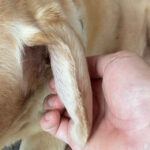 Dog Ear Hematomas: A Dog Owner’s Guide - It can be alarming to rub your dog’s ear and feel a puffy, fluid-filled ear that once was soft and… [...]
Dog Ear Hematomas: A Dog Owner’s Guide - It can be alarming to rub your dog’s ear and feel a puffy, fluid-filled ear that once was soft and… [...]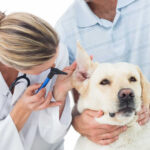 My Dog’s Ear Hematoma Popped: What Should I Do? - In my practice, we see dogs with ear hematomas at least once a month or more. It is incredibly rare… [...]
My Dog’s Ear Hematoma Popped: What Should I Do? - In my practice, we see dogs with ear hematomas at least once a month or more. It is incredibly rare… [...] Dog Ear Hematoma Wraps: A Dog Owner’s Guide - Image credit: No Flap Ear Wrap Manufacturer. Overnight your dog’s ear ballooned up into a hot, squishy mess known as… [...]
Dog Ear Hematoma Wraps: A Dog Owner’s Guide - Image credit: No Flap Ear Wrap Manufacturer. Overnight your dog’s ear ballooned up into a hot, squishy mess known as… [...]Disclaimer: This website's content is not a substitute for veterinary care. Always consult with your veterinarian for healthcare decisions. Read More.


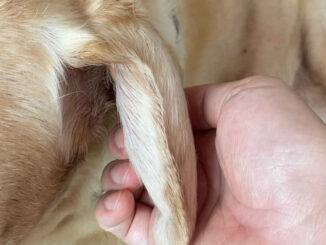
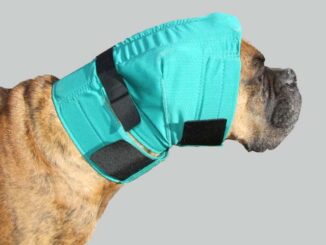

Be the first to comment